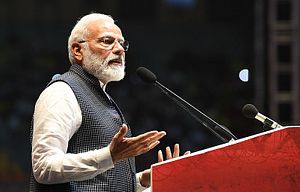Indian Finance Minister Nirmala Sitharaman presented the new budget for the country last week. From the perspective of defense modernization, the budget has yet again proved to be disappointing, with significant implications for India as well as other key partners and competitors.
Sitharaman announced an allocation of 4.71 trillion rupees (about $66.9 billion) for the Ministry of Defense (MoD), 15.49 percent of the total central government expenditure. Of this, almost $45.8 billion goes to meet the expenses of the army, navy, and air force as well as the Defense Research and Development Organization (DRDO). The rest of the allocation goes to meet defense pensions (about $19.0 billion) and MoD (Civil) (about $2.1 billion). The revised estimate for the previous year, 2019-20, was $65 billion.
The allocations for the various services are once again not very different from previous years: the army has received the biggest chunk of the allocation of 56 percent, the air force at 23 percent, and the navy has the smallest share at 15 percent. Over the last few years, India’s defense budget allocation has drawn unfavorable comparison to the budgets in the period prior to the 1962 war with China.
This year’s defense budget without the defense pensions amounts to a mere 1.5 percent of the GDP, which is noticeably low considering the state of the military. This figure is made worse by the fact that pensions accounted for only about 5 percent of the defense budget in 1960-61 but have skyrocketed to over 40 percent now, which in essence means that much less of the budget is going toward modernization of military equipment.
As I have written previously in The Diplomat (in 2018 and 2019) the current defense budget allocation comes against the backdrop of the 2018 Parliamentary Committee Report, which brought out severe deficiencies in the Indian military. Indian Vice Chief of Army Staff Lt. Gen. Sarath Chand in 2018 lamented the budget allocation, saying that it “has dashed our hopes.” He argued that as India looks at potentially fighting a two-front war scenario, the Indian military’s deficiencies are that much worse. He said then that unless the government makes necessary funds available for emergency procurement, the army, for instance, did not have war reserves to fight a high-intensity war beyond 10 days. In addition to the two fronts in the east and west, the Indian Army is also bogged down in internal security operations in the northeast and in Jammu and Kashmir.
Two years later, the situation has not improved much. Despite the Modi government’s national security rhetoric, it has failed when it comes to military modernization.
The capital expenditure that is available for the army is slightly less than $5 billion, for the navy it is less than $4 billion, and for the air force slightly more than $6 billion. These in effect cripple the Indian military’s efforts to modernize their weapon platforms. The Indian Army has been making efforts to procure a number of different platforms, including the M777 ultra-light howitzers and the K-9 Vajra self-propelled gun. Buying the indigenously produced 155 mm towed howitzers has also been an issue.
The Indian navy’s deficiencies are again well known. The fact that the number of operational submarines stands at 13 should be a reminder and warning to India of the state of the navy, especially at a time when the Chinese navy is probing the Indian Ocean. Indian efforts at developing the French Scorpene submarines has run into massive delays. The second of the six Scorpene submarine, INS Khanderi, was inducted into service only in September 2019. With the naval capability build-up being a time consuming and capital-intensive exercise, inadequate attention to and slow development of India’s naval capabilities can negatively affect India in any confrontation, including with Pakistan.
The Indian Air Force has its own woes, be it strengthening of the number of squadron or strengthening air defenses. Even though the Indian Air Force has a sanctioned strength of 42 squadrons, it is currently at a low of just about 31 squadrons. Out of the 31 squadrons, close to half of them belong to the vintage category such as the MiG-21s, MiG-27s, and Jaguars. The effort to get the French-built Rafale fighter has been caught in all sorts of problems, and the first four of 36 on order will only arrive this May.
There are no easy solutions to India’s budget problem. But the Indian government needs to consider radical solutions, including curtailing the size of the Indian army, and fast. The alternative is to have a very large but poorly-equipped force that will not be able to meet the challenges it is facing.

































